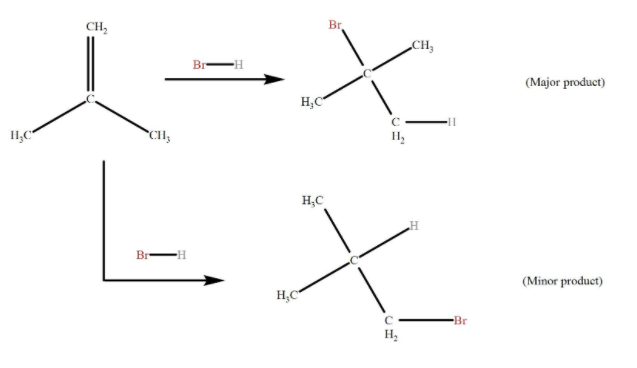
What is Markovnikov’s rule? Explain with an example.
Answer
433.9k+ views
Hint: We should know that Markovnikov’s rule is an empirical rule which is used to predict regioselectivity of electrophilic addition reaction of alkenes and alkynes. Keeping the purpose in mind, we need to describe the mechanism of Markovnikov's rule.
Complete step by step solution:
The Markovnikov’s rule states that with the addition of a protic acid HX to an asymmetric alkene, the acid hydrogen (H) gets attached to the carbon with more hydrogen substituents, and the halide (X) group gets attached to the carbon with more alkyl substituents.
Let us explain Markovnikov's rule with the help of a simple example.
When a protic acid HC (X = Cl, Br, I) is added to an asymmetrically substituted alkene, addition of acidic hydrogen takes place at the less substituted carbon atom of the double bond, while X is added to the more alkyl substituted carbon atom. In other words, hydrogen is added to the carbon atom with more number of hydrogen atoms attached to it and halide is added to the carbon with the least number of hydrogen atoms.
We should know that the driving force behind the reaction is the formation of carbocation in addition of H to the alkene, in the first step of the reaction. The most stable carbocation is formed when H is added to carbon having more number of hydrogen atoms already attached, due to factors like induction and hyperconjugation, which gives the major product with Br added to less hydrogen rich carbon.
Less stable carbocation (H added to less hydrogen rich carbon) is also present in small quantities, forming minor products in addition to Br to carbon having more hydrogen attached.

Note: There are various practical applications of Markovnikov’s rule. Some of them are Halohydrin formation (in alcohol and water), Oxymercurationand Demercuration and Acid catalysed hydration. These reactions are the laboratory usages of Markovnikov’s rule and are used in a variety of chemical processes.
Complete step by step solution:
The Markovnikov’s rule states that with the addition of a protic acid HX to an asymmetric alkene, the acid hydrogen (H) gets attached to the carbon with more hydrogen substituents, and the halide (X) group gets attached to the carbon with more alkyl substituents.
Let us explain Markovnikov's rule with the help of a simple example.
When a protic acid HC (X = Cl, Br, I) is added to an asymmetrically substituted alkene, addition of acidic hydrogen takes place at the less substituted carbon atom of the double bond, while X is added to the more alkyl substituted carbon atom. In other words, hydrogen is added to the carbon atom with more number of hydrogen atoms attached to it and halide is added to the carbon with the least number of hydrogen atoms.
We should know that the driving force behind the reaction is the formation of carbocation in addition of H to the alkene, in the first step of the reaction. The most stable carbocation is formed when H is added to carbon having more number of hydrogen atoms already attached, due to factors like induction and hyperconjugation, which gives the major product with Br added to less hydrogen rich carbon.
Less stable carbocation (H added to less hydrogen rich carbon) is also present in small quantities, forming minor products in addition to Br to carbon having more hydrogen attached.

Note: There are various practical applications of Markovnikov’s rule. Some of them are Halohydrin formation (in alcohol and water), Oxymercurationand Demercuration and Acid catalysed hydration. These reactions are the laboratory usages of Markovnikov’s rule and are used in a variety of chemical processes.
Recently Updated Pages
Difference Between Crystalline and Amorphous Solid

JEE Main Participating Colleges 2024 - A Complete List of Top Colleges

JEE Main Maths Paper Pattern 2025 – Marking, Sections & Tips

Sign up for JEE Main 2025 Live Classes - Vedantu

JEE Main 2025 Helpline Numbers - Center Contact, Phone Number, Address

JEE Main Course 2025 - Important Updates and Details

Trending doubts
JEE Main 2025 Session 2: Application Form (Out), Exam Dates (Released), Eligibility, & More

JEE Main Exam Marking Scheme: Detailed Breakdown of Marks and Negative Marking

JEE Main 2025: Derivation of Equation of Trajectory in Physics

Electric Field Due to Uniformly Charged Ring for JEE Main 2025 - Formula and Derivation

Types of Solutions

Learn About Angle Of Deviation In Prism: JEE Main Physics 2025

Other Pages
NCERT Solutions for Class 11 Chemistry Chapter 9 Hydrocarbons

JEE Advanced Marks vs Ranks 2025: Understanding Category-wise Qualifying Marks and Previous Year Cut-offs

JEE Advanced 2025: Dates, Registration, Syllabus, Eligibility Criteria and More

NCERT Solutions for Class 11 Chemistry Chapter 5 Thermodynamics

Hydrocarbons Class 11 Notes: CBSE Chemistry Chapter 9

JEE Advanced Weightage 2025 Chapter-Wise for Physics, Maths and Chemistry




